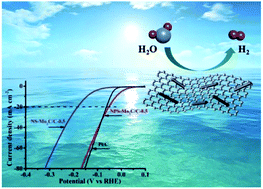Insights into N, P, S multi-doped Mo2C/C composites as highly efficient hydrogen evolution reaction catalysts†
Abstract
Heteroatom doping has been proved to be an effective strategy to optimize the activity of hydrogen evolution reaction (HER) catalysts. Herein, we report N, P, S multi-doped Mo2C/C composites exhibiting highly efficient HER performance in acidic solution, which are facilely fabricated via annealing of N, P, S-containing MoOx–polyaniline (MoOx–PANI) hybrid precursors. The optimized N, P, S multi-doped Mo2C/C catalyst with a moderate P dopant level (NPS-Mo2C/C-0.5) exhibits excellent performance with an overpotential of 53 mV to achieve a current density of 20 mA cm−2, a Tafel slope of 72 mV dec−1 and good stability in acidic electrolytes. Based on the study of XPS, EPR and 31P MAS NMR, the excellent electrocatalytic performance could be attributed to the effective electronic configuration modulation of both Mo2C nanorods and the carbon matrix, derived from stronger synergistic N, P, S multi-doping coupling effects. This work provides a promising methodology for the design and fabrication of multi-doped transition metal based electrocatalysts via electronic structure engineering.



 Please wait while we load your content...
Please wait while we load your content...